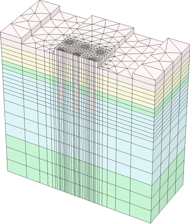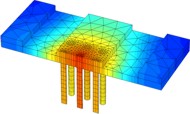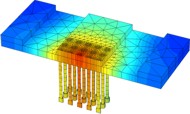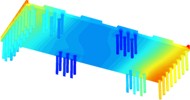skip to content
back to top
 Foundation of a raft with high point loads
Foundation of a raft with high point loads
|
|
Project:
Stuttgart, Germany
Customer:
Smoltczyk & Partner, Stuttgart
Project description:
Within the project in the city center of Stuttgart high point loads have to be carried into the subsoil. A piled raft foundation is planned in this project and the performance of the raft had to be investigated.
Subsoil:
Triassic layers, mainly variably weathered Gypsum Marl and in some areas sediments and fill.
Scope of work:
- Preliminary studies on possible alternatives for the foundation
- Three-dimensional Finite Element analyses of the foundation
- Three-dimensional Finite Element analyses of different alternatives for the piled raft foundation underneath the columns
- Investigated alternatives:
- 3x3 group of bored piles underneath the columns
- 3x3 group of driven cast-in-place concrete piles underneath the columns
- 4x4 group of driven cast-in-place concrete piles underneath the columns
- 5x5 group of driven cast-in-place concrete piles underneath the columns
- Three dimensional Finite Element analysis of a section over the total width of the foundation slab with 57 bored piles
- Calibration of the soil parameters using results of static pile load tests
- Determination of bedding modulus for a classic design of the foundation slab
Used Finite Element Code:
PLAXIS 2D V8.6
PLAXIS 3D Foundations V2.1
Used constitutive laws:
Linear elasticity (generalized Hooke)
Hardening-Soil model (elasto-plastic) + Small-Strain-Stiffness
Typical model size:
| Model of the section with one column: 36 m x 15 m x 36 m 13.800 to 30.700 wedge elements with quadratic interpolation 39.600 to 84.700 nodes |
Model of the complete section: 196 m x 30 m x 36 m 63.000 wedge elements with quadratic interpolation 185.000 nodes |




